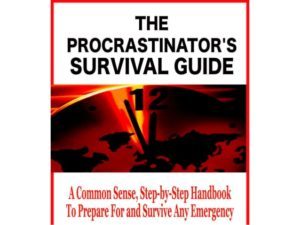Survival 2: Introduction

Task One-again. Mild: Did you get the two cases of water bottles for each person in your household?
If you did, you’ve just taken the
most important step in preparation for an emergency or natural disaster: an
adequate supply of water for at least six days for each person.
If you didn’t, you’re still procrastinating,
but you get points for continuing to read! So good news-bad news. Now get that
water!
Each time you see the Special
Forces patch in this book, it indicates a task you should do to prepare. These
items are numbered and in a combined checklist at the end so you can keep track
of how you’re doing.
This book is designed for you. The
person who has concerns about whether you are adequately prepared for
emergencies and disasters but hasn’t been able to focus on it, or when you do,
quickly get overwhelmed by the information available. It is written to help you
prepare for and deal with a wide array of possible situations in a
common-sense, step by step manner.
We are constantly being bombarded with
images of people caught in both natural and unnatural emergencies and disasters.
They appear on our television screen and we watch the devastation, confusion
and chaos with a combination of relief and fear. Relief because it’s not us and
fear because even though we bury the emotion, telling ourselves that won’t
happen to us, we know deep down that accidents, disasters and emergencies
do not discriminate and can strike anyone, anywhere, at any time. You, and
someone you love, will definitely face at least one of the topics covered in
this book.
The key is to be prepared and this book
will show you how to do it. It gives you checklists that you can readily follow
in order to be ready. It also allows you to prepare by levels, from mild to
moderate to extreme. Finally, it tells you what to do in various scenarios.
There are two main parts. The first
is preparation. The second is survival.
Task
Two
Mild: A-Team Contact Information &
Alert Flow
A-Team Member
Cell Phone
Number
Work/School
Address & Phone #
#1
#2
#3
#4
#5
#6
#7
#8
#9
#10
The out or area emergency point of
contact is someone who would be unaffected by a local disaster or weather event
and everyone can contact to update their status. This is in case you can’t
contact each other in the midst of the emergency/disaster.
We’ll discuss the Immediate Rally
Point and Emergency Rally Point later, but for now think of the first as a
place outside, but near to your house where everyone would gather if, for
example, there was a fire in the home and you had to evacuate in the middle of
the night.
The Emergency Rally Point is a
place further away from your house, a secure location, where your family/team
would gather if caught in a large scale disaster/emergency and you needed to
get together. This could be a relative’s home, work place, school, whatever.
Mild:
Out of Area Contact, Immediate Rally Point, Emergency Rally Point
Out of area
contact location, phone #
Immediate Rally
Point location
Emergency Rally
Point location
Mild: Emergency Information
Place
Phone
Address
Poison Control
800-222-1222
N/A
Work #1 for ?
Work #2 for ?
School #1 for ?
School #2 for ?
Closest police station
Closest emergency room
Closest fire station
Power company/
Gas company
Water company
Family Doctor
Health Insurance &
Account #
Insurance company
Account #
We’re on a roll. You now have more information and are more prepared than you were when you started this book. Remember, many of us don’t have phone numbers memorized. We rely on the address book of our cell phone, but in an emergency, that might not work, you might not have your cell phone and have to use someone else’s, or, well, as you shall see, there are many other reasons to actually have these numbers and locations written down.
The Procrastinator’s Survival Guide



